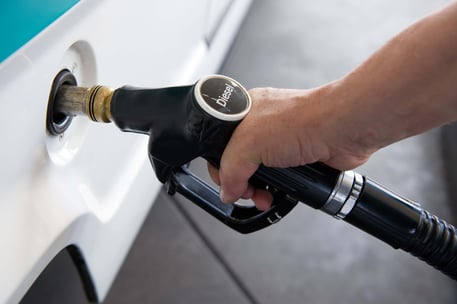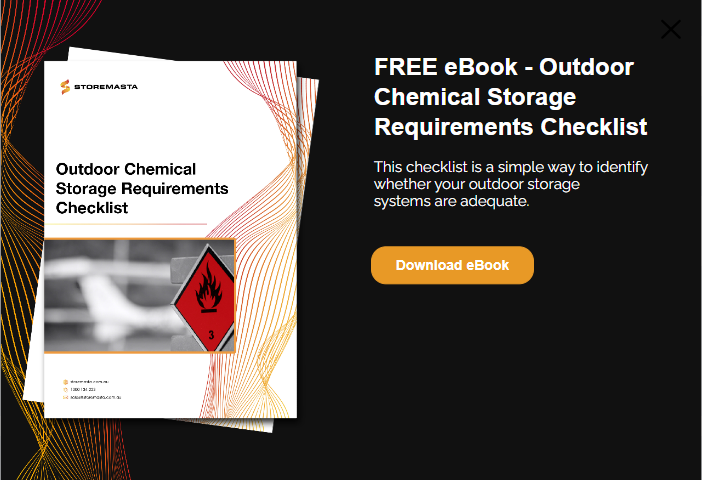When you work with dangerous or hazardous goods, you need to understand how to store them safely. Class 3 flammable liquids can cause workplace fires and explosions, so it's vital that they’re stored in carefully controlled environments. In this blog, we look at the flash points of commonly used flammable liquids and detail the requirements for their safe storage.
What Determines a Flammable Liquid?
To understand the hazards associated with flammable liquids and their flash points, we should first look at the definition of a flammable liquid.
The Australian Dangerous Goods (ADG) Code, states that flammable liquids are liquids that give off enough flammable vapours — at temperatures of 60 °C closed-cup test, or not more than 65.6 °C, open-cup test — to ignite in the presents of an ignition source (known as the flash point).
The ADG Code explains that the flammable liquids class also includes:
CHAPTER 2.3 - CLASS 3 – FLAMMABLE LIQUIDS
2.3.1.2 Flammable liquids
(a) liquids offered for transport at temperatures at or above their flash point; and
(b) substances that are transported or offered for transport at elevated temperatures in a liquid state and which give off a flammable vapour at a temperature at or below the maximum transport temperature.
NOTE: The results of open-cup tests and of closed-cup tests are not strictly comparable and even individual results by the same test are often variable.
What is a Flash Point?
As we have discussed, the flash point of a flammable liquid is the lowest temperature at which vapours of that liquid will ignite when close to an ignition source.
As temperatures increase, and flammable fuels become more gaseous, they will generally give off certain levels of vapour. When there is sufficient vapour to ignite, the flash point has been reached.
Therefore, with the potential for ignition, safety is paramount when you’re considering the storage of flammable liquids. Everyone in your team, and particularly those responsible for WH&S, need to be educated about the flash points of fuels.
Unless all staff are paying close attention to the flash points of these substances, there is the very real threat of fires and explosions.
To get you started, we’ve collated some common examples of flammable liquids and their flash points — from lowest to highest. Read on to learn more about the hazards associated with flammable goods and their respective flash points.
Examples of Flammable Liquids with Flash Points Below 0
When you’re dealing with flammable liquids with a flash point below 0, you need to treat them with extreme care. These goods can ignite at any temperature.
To prevent the risk of workplace fires and explosions, flammable liquids with a flash point below 0 should generally be stored in a secure, temperature-controlled environment.
- Flash Point of Petrol
As petrol has a flash point of -43°C, a great deal of care must be taken when storing this flammable liquid. There are some general requirements for storing petrol safely so you can minimise any associated hazards. Firstly, store petrol in a building away from your main residence or place of business. Secondly, lock it in a chemical storage container or flammable cabinet so that it can’t be accessed by anyone without your prior knowledge. Lastly, if you are transferring petrol from a tank to a vehicle, always do so outside where the vapours can escape into the air. - Flash Point of Acetone
Acetone is another example of a flammable liquid with a very low flash point at -20°C. Above this temperature, it can take just 2.5% of acetone in the air to cause an explosion. Acetone should be stored in a temperature-controlled environment. Metal or glass containers are ideal for storing acetone, however, if you’re opting for plastic, make sure you choose a Low Density Polyethylene (LDPE) container for longer term storage. - Flash Point of Benzene
Benzene’s flash point sits at a chilly -12°C, so it’s regarded as a highly flammable liquid. This substance must be stored in a cool, dry area with good access to ventilation. Inhalation of benzene fumes has been linked to blood disorders such as anaemia and leukemia. Therefore, orgaisations must beware of inadequate storage, as prolonged exposure to benzene can result in chronic health issues. Hazchem experts recommend storing benzene in a flammable liquids storage cabinet that complies with AS1940-2017.

Petrol is a flammable liquid with a flash point below 0°C.
Examples of Flammable Goods with Flash Points Close to Room Temperature
The following examples are flammable liquids that have flash points near room temperature. This means that they can produce enough flammable vapours to ignite in normal storage and handling circumstances.
- Flash Point Of Ethanol
The flash point of ethanol is 16.6°C, which is likely to be just below room temperature. Only use ethanol is a well-ventilated area. Store this substance in a cool, dry spot and make sure that that area also has adequate ventilation in case of any ethanol vapour leaks. - Flash Point of Methanol
Methanol has a flash point that sits between 11 and 12°C. Store methanol somewhere cool and dry, away from electrical equipment where possible. Keep the tank it’s stored in grounded, and make sure the methanol is clearly labelled as toxic and flammable. - Flash Point of Kerosene
Kerosene’s flash point sits right on the boundary for flammable fuels at 38°C. Kerosene should be stored in a blue plastic container for ease of identification. Containers should always be clean and tightly sealed. Kerosene must not be stored in metal containers as this can cause contamination of the substance.
Examples of Flammable Goods with Higher Flash Points
A higher flash point means that the flammable liquid will ignite once temperatures hit a higher range. The following are some common examples of substances that have the higher flash point.
- Flash Point of Diesel
Ranging from 52° to 96°, diesel’s flash point is considered high enough to be non-flammable in most environments (hence its use in compression-ignition engines). However, it still requires careful storage and safety. Diesel should be clearly labelled and marked with a ‘Combustible Liquid C1’ tag. As dangerous goods specialists, we recommend Dispensing STations for simultaneous storage and dispensing of diesel. - Flash Point of Biodiesel
Biodiesel’s flash point of 130°C makes it a relatively stable flammable liquid. This substance should be stored in a cool, dry place, but be warned that biodiesel typically has a shelf life of 3-6 months. Make sure that your biodiesel stocks are used quickly, or check your stocks for signs of contamination. - Flash Point of Lube Oil
The flash point of lube oil is around the 187°C mark, rendering it relatively non-flammable. However, it still needs to be stored carefully. Again, somewhere cool and dry is your best bet. If possible, store it on bunds in a horizontal position – and always make sure it’s clearly labelled.

Real-Life Incidences of Flammable Liquid Fires
Unfortunately, real-life incidences involving the ignition of flammable liquids are a common feature in news headlines across the globe. From petrol pump fires to factory blazes, we share some examples of the serious hazards associated with flammable liquids and their flash points.
Petrol Fire, Hyderabad, India
The driver of a black sedan was lucky to avoid disaster as his Skoda Superb caught on fire at the fuel pump.
Having left his vehicle while it was refuelling, the car burst into flames which spread through the handpiece and hose to the gas station.
NDTV reported that petrol spilled over during the refuelling, with the heat from the vehicle causing the fire. Emergency crews reached the scene quickly and were able to contain the fire.
Biodiesel Fire, Missouri, USA
A fire-storey column holding biodiesel at a Missouri stockyard holding biodiesel caught fire, with the top level engulfed in flames.
The fire department suggested that the blaze may have started when the biodiesel residue ignited after being heated by the sun.
News-Press Now stated that members of the fire crew suffered minor burns and one firefighter was treated for heat exhaustion.
Factory Fire, Sydney
A factory containing tens of thousands of litres of flammable and dangerous liquids became a raging toxic inferno when a massive fire broke out.
Fire crews arrived at the scene to see giant fireballs leaping 50m into the air.
Channel 9 reported that local residents were evacuated as 150 firefighters worked for hours to contain the blaze. When the blaze was under control by fire crews, residents were told to stay indoors and keep their windows shut to stop toxic smoke entering their properties.
Chemical fires can occur such as this devestating factory Fire in Sydney
Storing Flammable Liquids Safely
Hazardous goods storage is a serious workplace issue which needs to be taken seriously by your staff. It’s important to understand flammable liquids and their flash points, so you can make sure that they’re handled and stored in the appropriate manner. As a rule of thumb, flammable liquids should be stored in cool, dry, ventilated and secure areas to minimise the potential for fire or explosion. If you’d like to find out if your dangerous goods storage systems are safe and compliant, you can quickly download our free eBook Outdoor Dangerous Goods Storage Checklist.

Joining the team as a Dangerous Goods Storage Consultant, Melissa Hampton became Storemasta's Marketing Manager in late 2021. With extensive knowledge and experience in chemical compliance, Melissa is responsible for leading the Marketing team and helping shape their marketing strategy. In her spare time, you can find Melissa hiking, swimming and enjoying the great outdoors in beautiful north-west Tasmania.
